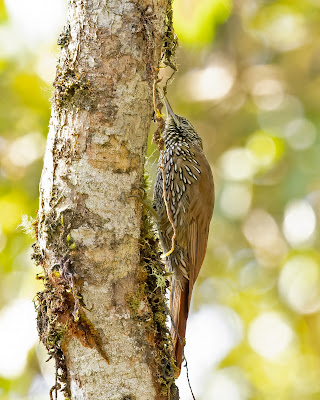Tuesday 2/22/2022 – Well last night was just cold and damp. Teri couldn’t get warm, so we ended up shoving our twin beds together and covering ourselves with blankets. She finally warmed up, but it was a night without much sleep. We made arrangement to change to a much smaller room with a single large bed for our second night.
We had breakfast at 6:30 and then headed out at 7:00 with Luisa to visit the site where the Bicolored Antpitta is fed. It was a small clearing with a single bench, and Luisa had a small bucket with worms and grubs to entice the bird. She called and called, and the bird called back once, but after thirty minutes we gave up.
We got in the SUV and headed up the road toward the ridge that we had tried yesterday afternoon. About 2/3 of the way up Daniel pulled over to drop us off at a second feeding site, this one for the Chestnut-crowned Antpitta.
Luisa spread about six earthworms along the top of a mossy perch, and the Antpitta appeared seconds later. We got amazing looks and pictures, and the Antpitta got some delicious worms.
She gathered up all of the worms in her mouth but didn’t eat them. Luisa said that she likely had nestlings and was taking the worms back to feed them.
From that site we walked up the road to the ridge and started birding.
In one direction was a beautiful view down onto the nearby city of Manizales, where Daniel lives. The other direction was forest and mountain ridges.

We walked the “long” stretch of road to the end, and then backtracked to the SUV. After a short break we walked the “short” stretch of the road in the opposite direction. With both Luisa and Daniel looking and calling we got on many good birds.
The ridge road allows looks into the tops of the trees and adjacent down-slope forest. So instead of craning your neck to look up into the tops of trees towering over you, you can look sideways.
We encountered a number of mixed feeding flocks and saw a nice variety of species. The highlight was Teri spotting a Tayra looking at us from a dead tree. The Tayra is the largest predator in the forest and is in the weasel family. I was a little slow with the camera and only got shots of it coming down the tree, but we were thrilled to have seen it.
Daniel came to get us at around 2:30, and we did a little birding around the lodge.
We then headed back up to the ridge. I think that Daniel and Luisa were hoping to get a few of the species that we’d missed in the morning, but it was still wet and drippy and the birds didn’t cooperate.
So we headed all the way back down the road to the entry station, to look for a specific hummingbird, the White-throated Daggerbill. This hummingbird feeds on a specific type of flowering shrub in the gardens of the entry station.
However, there are a couple of species of larger, more aggressive hummingbirds that attack it very quickly when it feeds, so Daniel warned us that we’d likely get only brief looks. We waited about 30 minutes before the hummer appeared, and sure enough a Collared Inca attacked it instantly and drove it away. A couple of minutes later it tried again, with the same result. But later I noticed it sitting quietly in the bush, and I took a few pictures of it. It then started to quietly feed and was able to do so for about 30 seconds before a Collared Inca appeared to run it off once again.
The entry station area also has a short dam and some
control structures, and we saw a White-capped Dipper on the surface of the dam
feeding. We then went up behind the dam to a rushing creek and got to see
Slaty-backed Chat-Tyrants.
We left the entry station and birded up and down the
road, finding a few mixed flocks and some good birds.
At one point Daniel said that he and Luisa might have a surprise for us, and we drove down to a spot on the road and got out. He showed us a female Lyre-tailed Nightjar sitting on a nest.
As dusk approached we headed back to that same area, hoping to see male Lyre-tailed Nightjars doing their impressive flight display. We’d gotten a single long-distance look at this in Ecuador and looked forward to seeing it again. The display in Ecuador took place about 200’ above our heads, and we were amazed when these Colombian birds started to display just 20 – 30’ up.
The males have a magnificent pair of long tail feathers that they can open very wide and flutter in flight. We had a pair of males doing this right over our heads, and one male perched on top of a nearby fence post, and later in some overhanging branches. It was very dark, but with the aid of a flashlight I was able to get some pictures of the perched male.
Before we left Daniel wanted to check the nest that we’d seen earlier in the day for an egg, as the female had left to feed. As we approached the nest we were shocked to find not an egg, but a furry white chick. We beat a hasty retreat so as not to disturb the check, and with the aid of a flashlight I got a decent picture.
We tried for owls on the way back but didn’t have any luck. We arrived back at the lodge a little after 7:00 and immediately sat down to a nice dinner.
Next time: Day 10
























































